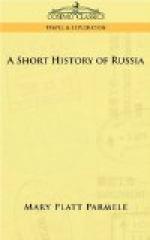Princes might come, and Princes might go, but an irrepressible spirit of freedom “went on forever”; the reigns all too short and troubled to disturb the ancient liberties and customs of the republic. No Grand Prince was ever powerful enough to impose upon them a Prince they did not want, and no Prince strong enough to oppose the will of the people; every act of his requiring the sanction of their posadnik, a high official—and every decision subject to reversal by the Vetche, the popular assembly. The Vetche was, in fact, the real sovereign of the proud republic which styled itself, “My Lord Novgorod the Great.” Such was the remarkable state which played an important, and certainly the most picturesque, part in the history of Russia.
The first thought of the new Grand Prince at Suzdal was to prevent the possible rivalry of this arrogant principality in the North, by conquering it and breaking its spirit. He was also resolved to break thoroughly with the past, to destroy the system of Appanages, and had conceived the idea of the modern undivided state. He removed his capital from the old town of Suzdal, which had its Vetche or popular assembly, to Vladimir, which had had none of these things, assigning as his reason, not that he intended to be sole master and free from all ancient trammels—but that the Mother of God had come to him in a dream and commanded him so to do! But an end came to all his dreams and ambitions. He was assassinated in 1174 by his own boyars, who were exasperated by his subversive policy and suspicions of his daring reforms.
With the setting of the currents of Russian national life toward the North, there was awakened in Europe a vague sense of danger. Not far from Novgorod, on and about the shores of the Baltic, were various tributary Slav tribes, mingled with pagan Finns. This was the only point of actual contact, the only point without natural protection between Russia and Europe, and it must be guarded. German merchants, hand in hand with Latin missionaries, invaded a strip of disputed territory, and, under the cloak of Christianity, commenced a—conquest. A Latin Church became also a fortress; and the fortress soon expanded into a German town, and these crept every year farther and farther into the East. In order to quell the resistance of native Finns and Slavs, there was created, and authorized by the Pope, an order of knighthood, called the “Sword-Bearers,” with the double purpose of driving back the Slavonic tide which threatened Germany and at the same time Christianizing it. These were the “Livonian Knights,” who came from Saxony and Westphalia, armed cap-a-pie, with red crosses embroidered upon the shoulder of their white mantles. Then another order was created (1225), the “Teutonic Order,” wearing black crosses on their shoulders, which, after fraternizing with the Livonian Knights, was going to absorb them—together with some




